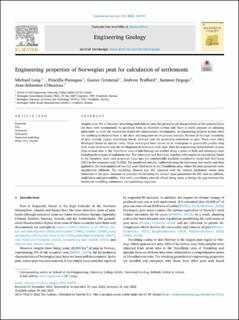| dc.contributor.author | Long, Mike | |
| dc.contributor.author | Paniagua Lopez, Ana Priscilla | |
| dc.contributor.author | Grimstad, Gustav | |
| dc.contributor.author | Trafford, Andrew | |
| dc.contributor.author | Degago, Samson Abate | |
| dc.contributor.author | L Heureux, Jean-Sebastien | |
| dc.date.accessioned | 2023-02-09T08:25:02Z | |
| dc.date.available | 2023-02-09T08:25:02Z | |
| dc.date.created | 2022-10-03T10:36:59Z | |
| dc.date.issued | 2022 | |
| dc.identifier.citation | Engineering Geology. 2022, 308 . | en_US |
| dc.identifier.issn | 0013-7952 | |
| dc.identifier.uri | https://hdl.handle.net/11250/3049510 | |
| dc.description.abstract | Despite some 9% of Norway's area being underlain by peat the geotechnical characteristics of the material have not been well documented. As peatlands form an excellent carbon sink there is much pressure on planning authorities to avoid the excavation of peat for infrastructure development. In engineering projects in peat often the resulting settlements both in the short and long term are of greatest concern. Because of the high variability of peat, several, largely empirically based, methods exist for predicting settlement on peat. These were often developed based on specific cases. These techniques have shown to be inadequate to generically predict long term creep settlements and the development of settlement with time. Here the engineering characteristics of peat from several sites in the Trondheim area of mid-Norway are studied using a series of field and laboratory tests including three types of oedometer test. The laboratory and field data, together with empirical correlations found in the literature, were used to provide input into the commercially available constitutive model Soft Soil Creep (SSC) in the computer code PLAXIS. The model was initially calibrated using the laboratory test results and then applied to the back-analysis of two full scale field trials in the Trondheim area, where the peat properties were significantly different. The modelling showed that SSC captured well the vertical settlement versus time behaviour of the peat. Guidance is provided for selecting the critical input parameters for SSC such as stiffness, yield stress and permeability. This work contributes towards efforts being made to bridge the gap between the numerical modelling community and practicing engineers. | en_US |
| dc.language.iso | eng | en_US |
| dc.publisher | Elsevier Science | en_US |
| dc.rights | Navngivelse 4.0 Internasjonal | * |
| dc.rights.uri | http://creativecommons.org/licenses/by/4.0/deed.no | * |
| dc.title | Engineering properties of Norwegian peat for calculation of settlements | en_US |
| dc.title.alternative | Engineering properties of Norwegian peat for calculation of settlements | en_US |
| dc.type | Peer reviewed | en_US |
| dc.type | Journal article | en_US |
| dc.description.version | publishedVersion | en_US |
| dc.source.pagenumber | 18 | en_US |
| dc.source.volume | 308 | en_US |
| dc.source.journal | Engineering Geology | en_US |
| dc.identifier.doi | 10.1016/j.enggeo.2022.106799 | |
| dc.identifier.cristin | 2057716 | |
| cristin.ispublished | true | |
| cristin.fulltext | original | |
| cristin.qualitycode | 1 | |

